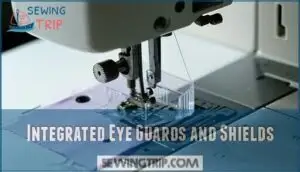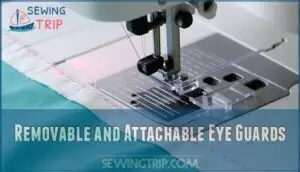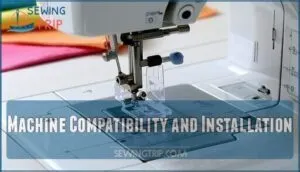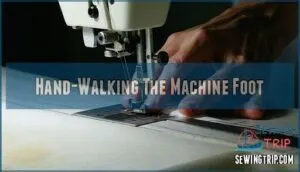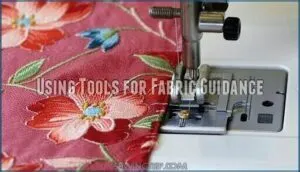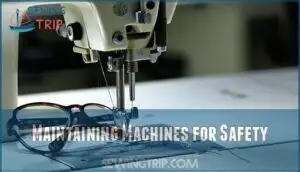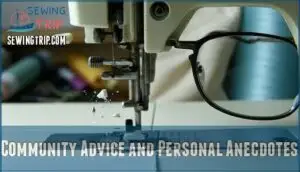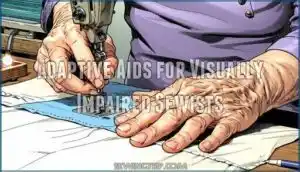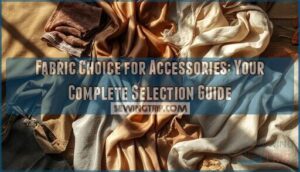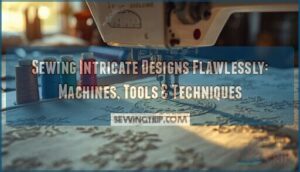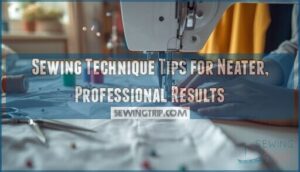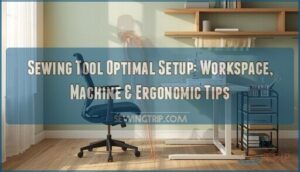This site is supported by our readers. We may earn a commission, at no cost to you, if you purchase through links.
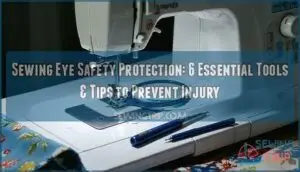
Effective sewing eye safety protection starts with proper lighting, like LED desk lamps that eliminate shadows around your work area.
Eye guards on your machine deflect debris, while magnifying tools reduce squinting, and quality seam rippers with built-in lights help you see clearly during detail work.
Take breaks every 30 minutes to prevent fatigue, and always hand-walk your machine when threading or adjusting fabric near the needle to ensure smooth, confident stitching sessions.
The right combination of tools and techniques transforms potentially dangerous moments into safe and efficient sewing experiences, making effective sewing eye safety protection a top priority.
Table Of Contents
Key Takeaways
- Install proper lighting and eye guards – You’ll need bright LED desk lamps to eliminate shadows and machine-mounted eye guards to deflect flying needle fragments and debris from reaching your eyes.
- Use magnifying tools and take regular breaks – You should invest in magnified LED seam rippers and take 20-30 minute breaks to prevent eye strain and maintain clear vision during detailed work.
- Practice safe sewing techniques – You’ll protect yourself by hand-walking your machine through pin areas, removing pins before they reach the needle, and using tools like awls to guide fabric instead of your fingers.
- Maintain your equipment for safety – You need to keep your machine properly serviced with sharp needles, correct thread tension, and clean mechanisms to prevent unexpected needle breakage that can send fragments toward your face.
Sewing Eye Safety Basics
Your eyes face serious risks every time you sit down to sew, from flying needle fragments to thread debris that can cause permanent damage.
Understanding these hazards and taking proper precautions will protect your vision and keep you sewing safely for years to come, which is crucial for permanent damage prevention.
Importance of Eye Protection
Your eyes face constant risk during sewing operations. Broken needles can fracture and fly at high speed, creating direct eye trauma hazards. Safety awareness protects your vision preservation and guarantees long-term health through proper risk mitigation strategies.
Every stitch carries risk—protect your vision before tragedy strikes.
Essential eye protection sewing considerations:
- Needle fragments – Sharp metal pieces can cause permanent vision damage
- Thread debris – Small particles create irritation and potential corneal scratches
- Machine vibrations – Sudden movements increase accident probability during precision work
- Fatigue factors – Tired eyes make poor safety decisions and reduce reaction times
- Workspace lighting – Poor visibility forces you closer to dangerous moving parts
Sewing eye safety requires proactive injury prevention measures. Addressing blurred vision signals eye fatigue, which is vital for maintaining focus and preventing accidents. Safety eyewear sewing protection acts as your first defense against eye injury prevention emergencies that can end your crafting passion permanently.
Common Eye Injuries in Sewing
Broken needles pose the greatest threat to your vision during sewing activities.
Your needle fragments can shatter and strike your eyes without warning, making broken needles every sewist’s silent enemy.
Needle fragment risks include flying debris that can strike your eye directly, causing corneal abrasions or deeper trauma.
While incident rarity statistics show only 7.7% of garment industry injuries involve eyes, operator statistics reveal 33.3% of textile eye injuries affect seamstresses.
Flying debris from needle breakage occurs when sewing thick materials or striking pins, making injury prevention essential for maintaining sewing eye safety.
These injuries can be caused by airborne particles impacting the eye, leading to serious consequences for sewing eye safety and overall eye health.
Preventing Accidents With Proper Techniques
Safe sewing practices substantially reduce needle hazards and protect your vision.
Master these sewing precautions to maintain eye safety while working at your machine.
Key Techniques for Safe Speed and Tool Usage:
- Maintain Safe Speed – Control your sewing machine’s pace, especially around thick seams or challenging fabric areas where needle breakage commonly occurs.
- Practice Pin Avoidance – Remove pins before they reach the needle area rather than attempting to sew over them, which can cause dangerous needle fragments.
- Focus on Machine Maintenance – Keep your sewing machine properly serviced with sharp needles and clean mechanisms to prevent unexpected breakage during focused sewing sessions.
Choosing Safe Sewing Machines
When you’re shopping for a new sewing machine, prioritize models with built-in eye protection features that’ll keep your vision safe during long stitching sessions.
Modern machines often include integrated shields, removable guards, or compatibility with aftermarket eye protection accessories that can prevent needle fragments from reaching your eyes, which is crucial for eye protection.
Integrated Eye Guards and Shields
When manufacturers integrate transparent eye guards directly into sewing machines, you’re getting built-in shields that deliver consistent eye protection without compromising workflow.
These high-impact plastic barriers use ergonomic design principles, maintaining excellent visibility while blocking needle fragments during breakage incidents.
In 1962, a patent was issued for a finger shield and guard to enhance operator safety.
| Feature | Industrial Models | Domestic Models |
|---|---|---|
| Material choices | High-impact acrylic, polycarbonate | Clear plastic, lightweight polymers |
| Shield effectiveness | Captures 95%+ of needle fragments | Blocks most flying debris |
| Visibility impact | Minimal distortion, scratch-resistant | Good clarity, may scratch over time |
| Ergonomic design | Retractable, adjustable positioning | Fixed position, lightweight |
Removable and Attachable Eye Guards
Aftermarket Guards offer flexibility when your machine lacks built-in eye protection.
These removable shields attach through magnetic clips or screws, providing needle eye guard benefits without permanent modifications.
DIY Shields using polycarbonate materials work well for custom setups, while Universal Compatibility guarantees most attachment methods fit various machine brands.
You can find different styles of removable sewing shields online.
- Transparent polycarbonate shields that clip onto presser feet in under one minute
- Magnetic eye guard attachment systems that swing away during threading
- Steel-reinforced Guard Materials engineered for repeated removal without wear
Machine Compatibility and Installation
Installing eye guards varies by sewing machine model and manufacturer.
You’ll find guard attachment methods include clipping, screwing, or magnetic fastening systems.
Check your machine’s manual for model-specific guides, as compatibility issues can arise with aftermarket options.
DIY installation typically involves simple attachment processes, though some sewing machine accessories require professional setup for ideal eye guard clipping and secure positioning.
Top 6 Sewing Eye Safety Tools
You’ll need proper lighting and magnification tools to protect your eyes while sewing, especially when working with fine details or sharp needles.
These six essential tools combine illumination, magnification, and physical protection to prevent eye strain and potential injuries from broken needles or flying debris.
1. OttLite WingShade Floor Lamp Home Decor
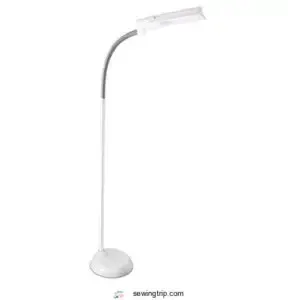
Looking at proper lighting can make all the difference in protecting your eyes while sewing.
The OttLite WingShade Floor Lamp delivers 930 lumens through its 18-watt True Color bulb, reducing eyestrain by up to 51% compared to standard bulbs.
You’ll appreciate the flexible gooseneck that directs light exactly where you need it, minimizing shadows over your work area.
The weighted base keeps everything stable while the wide shade covers your entire sewing table, preventing those dark spots that lead to visual fatigue.
Best For: Sewers, crafters, and hobbyists who want bright, adjustable, natural daylight illumination to reduce eyestrain and improve task accuracy.
- True Color bulb and wide shade deliver bright, clear light that mimics daylight, making details and colors easy to see.
- Flexible gooseneck and adjustable height let you direct the light exactly where you need it for any project.
- Sturdy, weighted base ensures stability and safety, even during extended or detailed work.
- Lack of swivel feature on the shade limits some directional adjustments.
- Some users may find the 13-watt version not bright enough for every task.
- Lamp generates noticeable heat during long use, which may affect comfort.
2. OttLite Natural Daylight LED Floor Lamp

The OttLite Natural Daylight LED Floor Lamp transforms your sewing experience with 708 lumens of natural daylight spectrum illumination.
This adjustable-height lamp reduces eyestrain by 51% compared to standard lighting, while its 12.5-inch shade covers large workspaces evenly.
You’ll appreciate the touch controls with memory function that recalls your preferred brightness setting.
The flexible neck positions precisely where you need it most, minimizing shadows and glare during detailed work, making it perfect for accurate color matching and extended sewing sessions with reduced eyestrain.
Best For: Sewers, crafters, and readers who need bright, natural daylight for detailed work and want to reduce eyestrain.
- Reduces eyestrain by 51% with ClearSun LED technology.
- Adjustable brightness and memory feature for custom settings.
- Flexible neck and broad shade provide even light across large workspaces.
- Touch controls can be awkward to find or overly sensitive in the dark.
- Mixed reviews about the stability and durability of the lamp base and joints.
- Higher price point compared to other floor lamps, despite quality.
3. Sewing Machine LED Light Strip
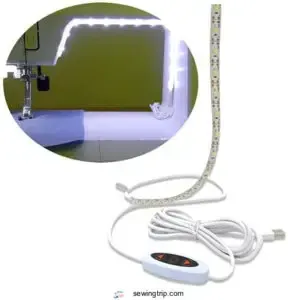
Strip away shadows and illuminate your work with precise LED lighting.
The Sewing Machine LED Light Strip delivers 24 LED chips across 12 inches, casting even, shadow-free illumination over your machine bed.
Its dimmable feature with subtle blue and purple hues reduces eye strain while enhancing focus during detailed work.
The resizable design fits various machine models, while the long power cable guarantees flexible setup.
This enhancement helps detect potential hazards like stray pins or needle fragments, promoting safer sewing sessions through consistent, professional-grade lighting.
These lights are also energy efficient LEDs, consuming less power, which is an important aspect of energy efficient design.
Best For: Sewers and quilters who need enhanced visibility, adjustable lighting, and reduced eye strain for precise, detailed machine work.
- Not ideal for machines requiring curved lighting strips.
- Some users find adhesive loses strength over time and may need replacement.
- Installation requires careful reading of instructions for proper fit.
- Bright, even, shadow-free illumination improves stitch accuracy and comfort.
- Dimmable with blue and purple hues to reduce eye strain and improve focus.
- Flexible, trim-to-fit design adapts to various machine models and setups.
4. Dritz Purple Magnified LED Seam Ripper
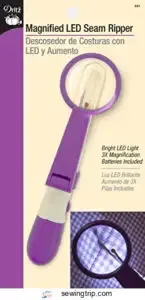
Beyond ordinary seam rippers, this purple powerhouse combines 3X magnification with bright LED lighting to transform your stitch removal experience.
The repositionable magnifier focuses precisely on tiny stitches while the LED illuminates dark fabrics, preventing accidental cuts that could send fabric fragments toward your eyes.
Slip-resistant grips and a protective cap enhance safety during storage and use.
The removable magnifier allows standard seam ripper functionality when needed, making this tool versatile for various sewing tasks requiring enhanced visibility and precision.
Best For: Sewists or quilters who need enhanced visibility, especially those with vision challenges or working in low-light conditions.
- Integrated 3X magnifier and LED light make it easy to see and remove even the tiniest stitches.
- Slip-resistant grip and protective cap improve safety and handling.
- Battery-powered lighting and removable magnifier add versatility for different fabrics and tasks.
- Some users report inconsistent blade sharpness and occasional need for sharpening.
- Magnifier may feel uncomfortable or cause eye strain during extended use.
- LED brightness could be stronger for maximum visibility.
5. Mighty Bright Lighted Seam Ripper
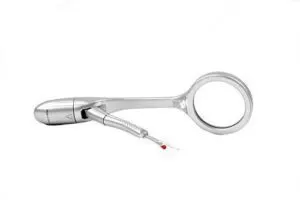
Featuring a bright white LED and 1.25-inch optical grade lens, the Mighty Bright Lighted Seam Ripper combines illumination with 4x magnification for safer stitch removal.
You’ll appreciate its ergonomic handle that reduces hand fatigue during extended use.
The LED lasts 100,000 hours and provides consistent lighting across dark fabrics, helping prevent accidental slips.
Its sharp metal blade folds safely into the handle, while the lightweight ABS plastic construction guarantees steady control.
This tool substantially reduces eye strain and improves precision, making it essential for sewists working in low-light conditions or handling delicate materials.
Best For: Sewists needing extra visibility and precision for removing stitches, especially those with vision challenges or who work in low-light environments.
- Magnifier can move, making alignment tricky.
- Blade may not be sharp enough for very fine stitches.
- No included protective pouch for storage.
- Bright LED light and magnifier improve accuracy and reduce eye strain.
- Ergonomic handle and lightweight build support comfortable, safer use.
- Blade folds safely into handle for secure storage.
6. Sewing Machine Needle Finger Guard Set
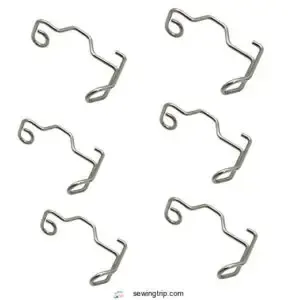
While eye protection steals the spotlight, your fingers deserve equal attention.
This universal finger guard set creates a protective barrier between your fingers and the needle’s path, preventing accidental contact during high-speed sewing.
The iron guards attach behind your presser foot screw, fitting most single needle industrial machines including Brother, Juki, and Singer models.
You’ll receive six guards per package, ensuring backup protection.
Though installation requires removing the foot screw, the process takes minutes and substantially reduces finger injury risk, especially for beginners and teaching environments.
This is a significant advantage, as it provides a safe sewing experience.
Best For: Parents, teachers, and beginners looking to prevent finger injuries while using industrial single-needle sewing machines.
- Provides a reliable safety barrier, reducing risk of finger injuries.
- Fits a wide range of popular industrial sewing machine brands.
- Ideal for educational and beginner environments to teach safe sewing habits.
- Not compatible with machines that have built-in threaders.
- Some users report unclear installation due to lack of instructions.
- Mixed feedback on product consistency and number of guards received.
Sewing Safety Tips and Best Practices
Beyond choosing the right safety tools, you’ll need to develop proper sewing habits that protect your eyes from injury.
These proven techniques and maintenance practices will help you avoid the most common hazards that can lead to broken needles and flying debris.
Hand-Walking The Machine Foot
When you encounter pins while sewing, hand-walking the machine foot provides superior control and prevents dangerous needle breakage.
This technique involves manually turning the handwheel to move the needle through pin-heavy areas, ensuring fabric stability and stitch precision.
Pin avoidance through careful foot control reduces eye injury risks substantially, making this essential sewing safety practice invaluable for protecting your vision during machine operation.
Using Tools for Fabric Guidance
When guiding fabric through your sewing machine, smart tool choices keep your fingers away from the needle zone. These accessories provide precise fabric manipulation while maintaining essential finger protection during detailed work.
- Awls and Skewers – Use pointed tools to guide fabric edges and hold seams in place without risking finger contact with the needle area
- Fondue Fork Safety – Repurpose kitchen fondue forks as fabric guides, keeping hands at safe distances while maintaining control over material flow
- Tool Alternatives – Bamboo skewers and cooking utensils work effectively as makeshift fabric guidance tools for various sewing projects
- Fabric Manipulation – Position guidance tools perpendicular to seam lines, allowing smooth fabric movement while protecting your vision from potential needle fragments
Maintaining Machines for Safety
Regular sewing machine maintenance prevents needle breakage causes and reduces safety hazards.
Check feed dog covers remain securely fastened, as loose covers can catch fabric and snap needles.
Keep machine lubrication current according to manufacturer specifications.
Monitor thread tension issues that stress needles beyond breaking points.
Clean machine parts regularly to prevent debris buildup that affects sewing machine operation and safety features. Regular maintenance also helps prevent needle breakage.
Community Advice and Personal Anecdotes
Forum insights reveal how personal experiences shape sewing safety practices.
Many sewists initially resist protective eyewear until experiencing close calls with broken needles, which substantially shifts their safety vigilance approach.
- Personal experiences with needle fragments hitting faces create lasting awareness of injury rarity but real consequences
- Safety vigilance increases dramatically after peer accidents, with community members sharing protective strategies
- Tool alternatives like awls and seam rippers help maintain safer distances from needle paths
It’s also vital to maintain good posture while sewing to prevent back and shoulder pain. Forum insights emphasize that even reluctant sewists prefer eye safety tips over risking vision loss, highlighting the importance of protective eyewear and safer distances in their sewing practices.
Adaptive Aids for Visually Impaired Sewists
If you’re sewing with vision challenges, adaptive aids can transform your crafting experience from frustrating to enjoyable.
These specialized tools help you maintain precision and safety while working with fabrics, threads, and needles that might otherwise be difficult to see clearly, making the experience more enjoyable.
Correctable Vision Loss and Refractive Errors
Vision problems don’t have to end your sewing journey.
Schedule a thorough eye exam with your eye doctor to identify whether you’re dealing with correctable refractive errors or underlying conditions like dry eye or cataracts.
Updated prescriptions for reading glasses, specifically measured for your sewing distance, can dramatically improve your eye safety and comfort at the machine, which is crucial for a successful sewing experience with correctable refractive errors.
Magnified LED Seam Rippers and Head Magnifiers
Two powerful Vision Enhancement Options transform challenging sewing tasks into manageable work.
Magnified LED seam rippers combine LED Magnification Benefits with precise cutting, while head magnifiers provide hands-free magnification for detailed stitching.
These Adaptive Sewing Tools offer 3x-4x magnification with ergonomic design, reducing eye strain during intricate projects and enhancing Head Magnifier Comfort for extended use.
You can find a magnified LED ripper to assist with detailed work.
Clip-on Magnifying Lenses and Adaptive Aids
Clip-on magnifying lenses transform your glasses into powerful sewing aids, offering 1.5X to 5.0X magnification levels for detailed work.
These vision correction tools provide ergonomic benefits by reducing forward leaning and neck strain. Flip-up designs allow quick switches between normal and magnified vision.
For enhanced precision, consider magnetic seam guides. Accessibility options include compatibility with prescription glasses, making them ideal vision impairment solutions for sewing machine magnification and precise needlework.
Frequently Asked Questions (FAQs)
Where can I buy sewing machine eye guards?
You can buy sewing machine eye guards from College Sewing Machine Parts at (+44) 0161 763 6969, online retailers, or directly from your sewing machine manufacturer.
Many are available as accessories for most industrial machines.
Should you wear protective eyewear when using a sewing machine?
Like a shield protecting precious cargo, protective eyewear creates a barrier between your eyes and potential sewing hazards.
You should wear safety glasses or goggles when sewing, especially with new machines or techniques, as broken needles can fly at high speed and cause direct eye trauma.
How to protect your eyes when sewing?
Use safety glasses or eye shields when sewing to protect against broken needle fragments.
Install machine-specific eye guards, maintain proper lighting, and keep hands away from the needle area.
Consider magnifying aids for detailed work.
How can I improve my eye health while sewing?
Take regular breaks every 20-30 minutes to rest your eyes and prevent strain.
Improve lighting with bright, even illumination over your workspace.
Consider reading glasses if you’re over 40, and use magnifying tools for detailed work to reduce squinting and eye fatigue.
How can sewing affect your eyes?
Your thread becomes tangled when poor lighting strains your eyes, causing fatigue, headaches, and blurred vision.
Broken needles can fly toward your face, while prolonged close-up work leads to dry eyes and neck strain from awkward positioning.
What is the purpose of an eye guard?
An eye guard creates a protective barrier between you and the needle, shielding your eyes from broken needle fragments, flying debris, and accidental contact during sewing operations.
While maintaining clear visibility, it ensures your safety during these operations.
Should you wear safety glasses while sewing?
Protection from projectiles becomes absolutely essential when needle fragments can rocket toward your face.
You should wear safety glasses while sewing, especially when using industrial machines or trying new techniques.
Broken needles fly at high speeds, causing potential eye trauma that represents 7% of occupational garment injuries.
What are the OSHA rules for eye protection?
According to OSHA requires employers to guarantee employees use appropriate eye protection when exposed to hazards from flying particles, molten metal, liquid chemicals, acids, chemical gases, or potentially injurious light radiation.
Side protection is mandatory when there’s a hazard from flying objects
What is the #1 item to protect eyes?
Ironically, you’ll need multiple layers of protection since no single item guarantees complete eye safety.
Safety glasses provide your primary defense, but eye guards on machines and proper lighting create thorough protection for detailed work.
What PPE could you use when sewing to ensure safety?
You’ll want safety glasses or goggles as your first line of defense, plus eye guards or shields that attach directly to your machine.
These transparent barriers protect against needle fragments and flying debris while maintaining clear visibility of your work area, acting as a crucial defense.
Conclusion
Remember the old saying about an ounce of prevention? That wisdom applies perfectly to sewing eye safety protection.
You’ve learned that proper lighting, machine guards, and magnifying tools aren’t just nice-to-have accessories—they’re essential shields for your vision.
By combining quality equipment with safe techniques like hand-walking your machine and taking regular breaks, you’ll protect your eyes while enjoying countless hours of creative stitching.
Your future self will thank you for investing in these simple yet vital safety measures today.
- https://pubmed.ncbi.nlm.nih.gov/32774391/
- http://quiltingdigest.com/sewing-machine-safety-tips/
- https://periodicos.ufpe.br/revistas/index.php/revistaenfermagem/article/download/9815/9992/18479
- https://www.universalsewing.com/safety-equipment-and-supplies
- https://www.reddit.com/r/sewing/comments/3os9op/can_you_share_some_tips_on_how_to_prevent_injury/

